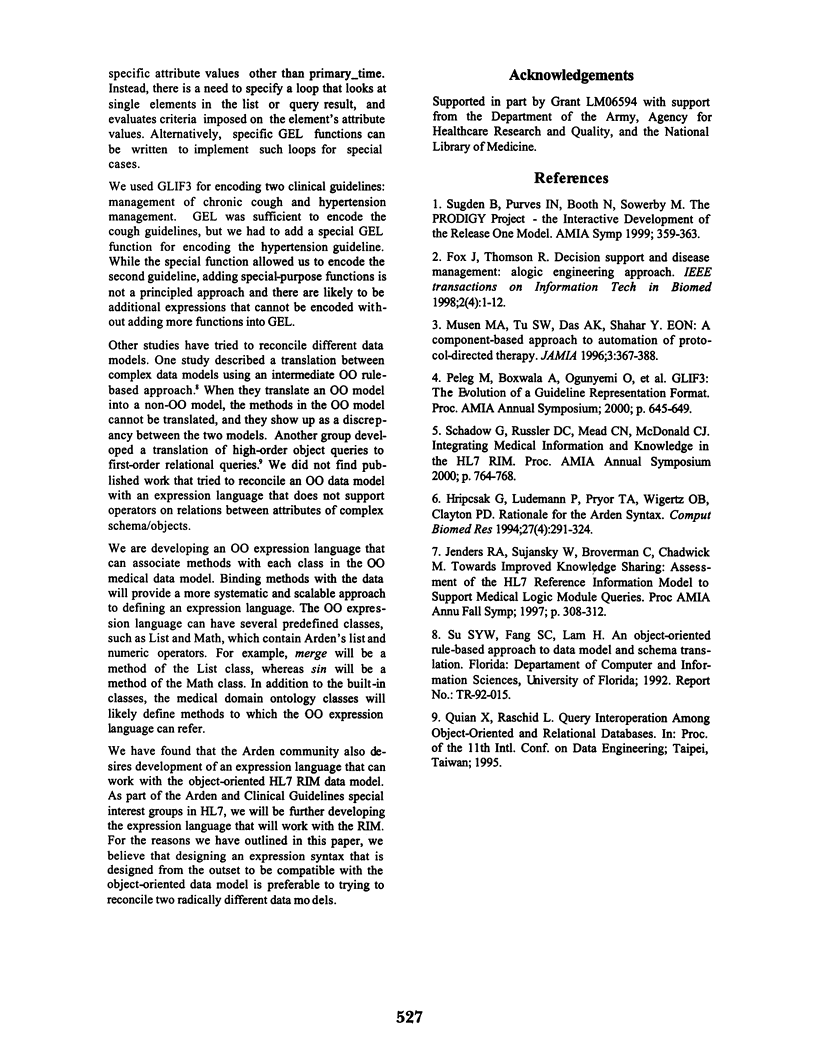Abstract
Computer-interpretable guidelines (CIGs) can deliver patient-specific decision support at the point of care. CIGs base their recommendations on eligibility and decision criteria that relate medical concepts to patient data. CIG models use expression languages for specifying these criteria, and define models for medical data to which the expressions can refer. In developing version 3 of the GuideLine Interchange Format (GLIF3), we used existing standards as the medical data model and expression language. We investigated the object-oriented HL7 Reference Information Model (RIM) as a default data model. We developed an expression language, called GEL, based on Arden Syntax's logic grammar. Together with other GLIF constructs, GEL reconciles incompatibilities between the data models of Arden Syntax and the HL7 RIM. These incompatibilities include Arden's lack of support for complex data types and time intervals, and the mismatch between Arden's single primary time and multiple time attributes of the HL7 RIM.
Full text
PDF




Selected References
These references are in PubMed. This may not be the complete list of references from this article.
- Hripcsak G., Ludemann P., Pryor T. A., Wigertz O. B., Clayton P. D. Rationale for the Arden Syntax. Comput Biomed Res. 1994 Aug;27(4):291–324. doi: 10.1006/cbmr.1994.1023. [DOI] [PubMed] [Google Scholar]
- Jenders R. A., Sujansky W., Broverman C. A., Chadwick M. Towards improved knowledge sharing: assessment of the HL7 Reference Information Model to support medical logic module queries. Proc AMIA Annu Fall Symp. 1997:308–312. [PMC free article] [PubMed] [Google Scholar]
- Musen M. A., Tu S. W., Das A. K., Shahar Y. EON: a component-based approach to automation of protocol-directed therapy. J Am Med Inform Assoc. 1996 Nov-Dec;3(6):367–388. doi: 10.1136/jamia.1996.97084511. [DOI] [PMC free article] [PubMed] [Google Scholar]
- Peleg M., Boxwala A. A., Ogunyemi O., Zeng Q., Tu S., Lacson R., Bernstam E., Ash N., Mork P., Ohno-Machado L. GLIF3: the evolution of a guideline representation format. Proc AMIA Symp. 2000:645–649. [PMC free article] [PubMed] [Google Scholar]
- Purves I. N., Sugden B., Booth N., Sowerby M. The PRODIGY project--the iterative development of the release one model. Proc AMIA Symp. 1999:359–363. [PMC free article] [PubMed] [Google Scholar]
- Schadow G., Russler D. C., Mead C. N., McDonald C. J. Integrating medical information and knowledge in the HL7 RIM. Proc AMIA Symp. 2000:764–768. [PMC free article] [PubMed] [Google Scholar]


